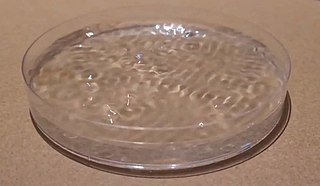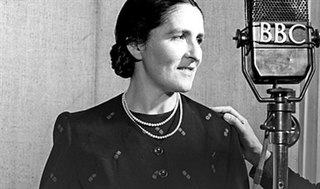
A kaleidoscope is an optical instrument with two or more reflecting surfaces tilted to each other at an angle, so that one or more objects on one end of these mirrors are shown as a regular symmetrical pattern when viewed from the other end, due to repeated reflection. These reflectors are usually enclosed in a tube, often containing on one end a cell with loose, colored pieces of glass or other transparent materials to be reflected into the viewed pattern. Rotation of the cell causes motion of the materials, resulting in an ever-changing view being presented.

A microphone, colloquially called a mic, is a transducer that converts sound into an electrical signal. Microphones are used in many applications such as telephones, hearing aids, public address systems for concert halls and public events, motion picture production, live and recorded audio engineering, sound recording, two-way radios, megaphones, and radio and television broadcasting. They are also used in computers and other electronic devices, such as mobile phones, for recording sounds, speech recognition, VoIP, and other purposes, such as ultrasonic sensors or knock sensors.

Ernst Florens Friedrich Chladni was a German physicist and musician. His most important work, for which he is sometimes labeled as the father of acoustics, included research on vibrating plates and the calculation of the speed of sound for different gases. He also undertook pioneering work in the study of meteorites and is regarded by some as the father of meteoritics.

Cymatics is a subset of modal vibrational phenomena. The term was coined by Swiss physician Hans Jenny (1904–1972). Typically the surface of a plate, diaphragm, or membrane is vibrated, and regions of maximum and minimum displacement are made visible in a thin coating of particles, paste, or liquid. Different patterns emerge in the excitatory medium depending on the geometry of the plate and the driving frequency.

Kate Roberts was one of the foremost Welsh-language authors of the 20th century. Styled Brenhines ein llên, she is known mainly for her short stories, but also wrote novels. Roberts was a prominent Welsh nationalist.
Helen Watts was a Welsh contralto.

Faraday waves, also known as Faraday ripples, named after Michael Faraday (1791–1867), are nonlinear standing waves that appear on liquids enclosed by a vibrating receptacle. When the vibration frequency exceeds a critical value, the flat hydrostatic surface becomes unstable. This is known as the Faraday instability. Faraday first described them in an appendix to an article in the Philosophical Transactions of the Royal Society of London in 1831.

Sir John Rhŷs, was a Welsh scholar, fellow of the British Academy, Celticist and the first professor of Celtic at Oxford University.

The invention of the telephone was the culmination of work done by more than one individual, and led to an array of lawsuits relating to the patent claims of several individuals and numerous companies.

Mary Davies was a Welsh mezzo-soprano and the co-founder and first President of the Welsh Folk Song Society. She was principal vocalist at the London Ballad Concerts, and at the National Eisteddfod of 1906.

Catrin ferch Owain Glyndŵr was one of the daughters of Margaret Hanmer and Owain Glyndŵr, and her marriage to a claimant on the English throne was used by her father to gain support.

Rachel Thomas OBE, was a Welsh character actress.

Leila Megane was a Welsh mezzo-soprano opera singer.
This article is about the particular significance of the year 1966 to Wales and its people.
Susan Derges is a British photographic artist living and working in Devon. She specialises in camera-less photographic processes, most often working with natural landscapes. She has exhibited extensively in Europe, America and Japan and her works are in several important museum collections.
This article is about the particular significance of the year 1891 to Wales and its people.

Welsh-language literature has been produced continuously since the emergence of Welsh from Brythonic as a distinct language in around the 5th century AD. The earliest Welsh literature was poetry, which was extremely intricate in form from its earliest known examples, a tradition sustained today. Poetry was followed by the first British prose literature in the 11th century. Welsh-language literature has repeatedly played a major part in the self-assertion of Wales and its people. It continues to be held in the highest regard, as evidenced by the size and enthusiasm of the audiences attending the annual National Eisteddfod of Wales, probably the largest amateur arts festival in Europe, which crowns the literary prize winners in a dignified ceremony.

Jill Purce is a British voice teacher, Family Constellations therapist, and author. In the 1970s, Purce developed a new way of working with the voice, introducing the teaching of group overtone chanting, producing a single note whilst amplifying vocal harmonics. She is a former fellow of King's College London, Biophysics Department. She produced over 30 books as general editor of the Thames and Hudson Art and Imagination series. Between 1971 and 1974, she worked in Germany with the composer Karlheinz Stockhausen. Since the early 1970s, she has taught diverse forms of contemplative chant, especially overtone chanting. For over 15 years, she has been leading Family Constellations combined with chant.

Susan "Sue" Dowdell Myrick was an American journalist, educator, author, and conservationist. Her friendship with author Margaret Mitchell led to Myrick's role as a technical advisor and dialect coach during the production of Gone with the Wind (1939), ensuring the film accurately portrayed the accents, customs, and manners of the South. Due to this expertise she has been called the "Emily Post of the South". Myrick also was a columnist, reporter, and associate editor for Macon-based newspaper The Telegraph, working at the paper for fifty years.
















